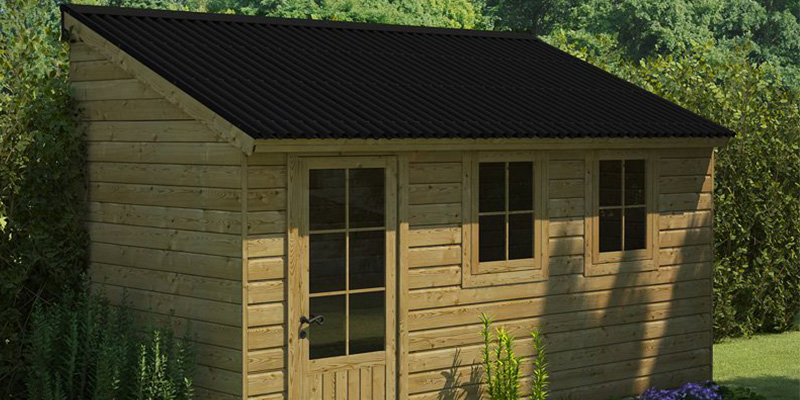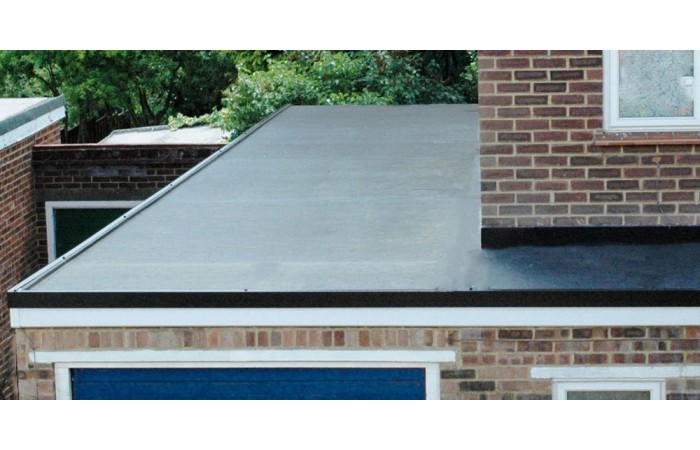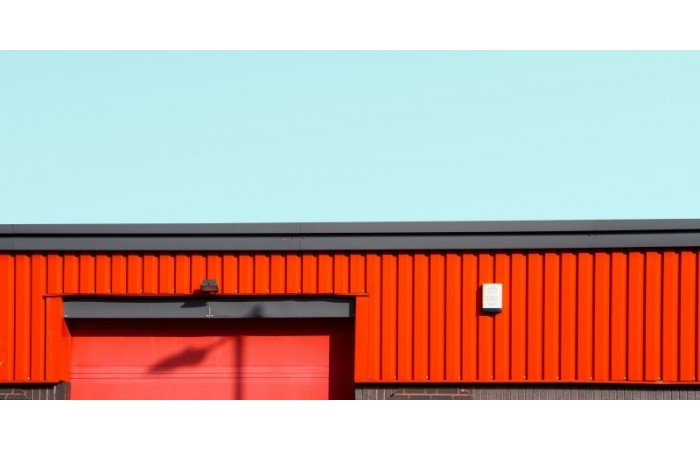What Are the Best Flat Roof Materials?

Whether you’re replacing a leaky garage roof, or you’re looking for something to protect your new pent roof shed, finding the right material is key. After all, the flat roof material you choose will play a major role in determining the longevity and reliability of your new roof. You want something that offers solid protection, whilst looking smart, and at a reasonable price.
But with such an abundance of different materials to choose from, it can be difficult to choose between them. That’s why we’ve written this guide to the best flat roof coverings, to help you find out more about the unique selling points and advantages of each, so you can make the best decision for your project.
Roofing Felt
Roofing felt is perhaps the most common flat roofing material available. It can be seen atop flat roofs right across Britain, largely thanks to its superb cost-effectiveness. A felt roof is straightforward to install, providing a reliable weatherproof seal to protect almost any flat roof. What’s more, a roof covered with felt can be repaired cheaply and easily, almost no matter the damage.
- Cost: Felt is known as the flat roof material that offers the greatest value for money, starting at less than £2 per square metre. Inexpensive to purchase initially, felt roofing is also economical to repair and replace whenever maintenance is needed across its lifetime.
- Durability: Whilst not the most durable flat roofing material, a felt roof still provides an effective watertight seal, and will resist severe weather and temperatures, as well as suffer moderate impacts without issue.
- Longevity: A felt roof can be expected to last around 15-20 years, depending on wear and tear and how well it is maintained. It is, however, not unheard of for roofing felt to last up to 25 or even 30 years.
- Installation: Roofing felt is notably simple to install, with a few different methods available. These include self-adhesion, torching-on, and fixing with nails or screws. Installing a new felt roof will take a few hours, and is often much faster to fit than other materials.
- Appearance: Whilst not offering the grand aesthetics of pitched roofing materials such as traditional tiles, roofing felt will still offer a smart, clean finish when installed correctly, with multiple colour options available.
- Great For: Roofing felt is an incredibly versatile material and can be used on virtually any flat roofing project, whether big or small. From garden sheds to garages, or even warehouses.
As stated, there are many different kinds of flat roofing felt. Whilst these share many similarities, there are a number of key differences that set them apart. These include performance, aesthetics, and most prominently, installation. Read our guide to felting a roof for more information on installing the roofing felt yourself.
Shed Felt
As the name would suggest, shed felt is specifically designed for use on garden sheds and other small outbuildings. Generally, a lighter weight than felt designed for bigger projects, shed roof felt often also features only a two-layer system rather than three. Other than that, a shed covered with felt will still enjoy many of the same benefits listed above.
- Cost: There are few shed roofing materials cheaper than felt. This makes the shed felt the ideal choice for homeowners looking to protect their garden tools and other belongings on a limited budget. If ever needed, repairing or replacing this felt won’t break the bank either.
- Durability: It should be noted that shed roof felt is one of the least durable options available for flat or pitched roof sheds, however, the Polyester PRO Shed Roof Felt, for example, will still give your shed fantastic protection against the weather, water ingress, high/low temperatures, and minor impacts.
- Longevity: 15 years, potentially lower or higher depending on conditions, wear-and-tear, and how well your felt shed roof is maintained.
- Installation: Most shed roof felt is applied either using fixings or cold self-adhesive, meaning it’s a breeze to install, even if you’re a homeowner new to DIY.
- Appearance: Felt will give your garden shed a smart, professional-looking finish, with a range of colours to suit you.
- Great For: As you might have guessed, we’d only suggest shed felt be used on garden sheds or similar outbuildings such as pergolas, or perhaps door canopies.
Torch-On Felt
On the surface, torch-on felt may appear similar to other types of roof felt. However, the key difference is can be found on the underside of the material. There you’ll find a thick layer of bitumen designed to be melted with a blowtorch onto your roof. That’s why we’d strongly recommend hiring professional help if you want to protect your flat roof with torch-on felt.
- Cost: Whilst torch-on felt is slightly more expensive than other varieties, it is still highly cost-effective compared to other flat roofing materials. The cost will vary depending on the brand, but you can expect to pay around £5 per square metre.
- Durability: Torch-on felt roofing is stronger than the other types of roofing felt, providing greater protection against water ingress, adverse weather, and impacts. Able to withstand whatever is thrown at it year-round, torch-on felt is a great choice for larger projects.
- Longevity: 20 years or so, depending on damage and maintenance across its lifespan. When installed correctly, along with plywood or fibreglass underlay, you can expect greater longevity.
- Installation: As stated, torch-on felt is perhaps the most difficult flat roofing material to install. Due to the relative danger, and expertise required, applying a torch-on felt roof yourself is not advised.
- Appearance: Torch-on roof felt is usually limited to darker colours such as black and grey, as these are what keep best after being applied with extreme heat.
- Great For: Most suitable for larger projects, torch-on felt can be used on large garages or extensions, as well as commercial buildings such as warehouses or factories.
Self-Adhesive Felt
The perfect choice for those new to DIY, or just looking for hassle-free installation. Self-adhesive roof felt is incredibly simple to apply, while still boasting many of the same benefits other forms of roofing felt do at the same time. Perfect for flat roofing projects big and small.
- Cost: Another incredibly low-cost flat roofing option, self-adhesive felt will set you back as little as £2-3 per square metre. Ideal for budget-conscious homeowners.
- Durability: Offering the same solid levels of resistance to adverse weather, temperatures, moisture ingress, and impacts as other forms of roofing felt, self-adhesive felt provides fair durability for its low cost.
- Longevity: 10-20 years before needing a full replacement, or even longer if installed correctly and not exposed to extreme weather conditions.
- Installation: One of the easiest flat roofing materials to install, self-adhesive felt is applied by simply pressing the handily-sized roll across the roof and fixing it down. Do ensure that your roof is clean and free of any debris before applying.
- Appearance: Most commonly available in either black or green, self-adhesive felt is just the thing to achieve a smart finish to a flat roofing project such as a shed or garage roof replacement.
- Great For: A fantastic all-rounder, self-adhesive felt is best suited to small or medium-sized residential projects. These include sheds, garages, extensions, and more.
EPDM Membranes
Quite possibly the best flat roofing membrane, EPDM is a relatively low-cost flat roof material that offers a number of significant advantages. Clean, straightforward installation, incredible strength, a long lifespan, and a smart finish combine to make EPDM membranes difficult to beat. It’s easy to see why they’re favoured by DIYers and tradespeople alike, and are in use up and down Britain.
- Cost: At a moderate cost of £9 per square metre, EPDM still offers great value for money when you consider both its strength and longevity. Repairs and patch-replacements are also economical, if they’re ever needed.
- Durability: Fully waterproof, highly resistant to weather and temperature conditions, and able to absorb strong impacts, a flat roof covered with an EPDM membrane can withstand almost anything.
- Longevity: An EPDM roof can be expected to last for 40-50 years, with very little maintenance or repairs required across this time.
- Installation: Fitting an EPDM membrane onto a flat roof is fairly straightforward, especially thanks to the complete system of accessories and fixings provided by manufacturers.
- Appearance: Whilst EPDM remains a firm favourite due to its simple installation process and incredible performance, it is not highly visually appealing. Whilst an EPDM roof will look seamless when correctly installed, there are few colours available aside from shades of black or grey.
- Great For: Projects of any size, including garage roof replacements, flat extension roofs, commercial premises, and more.
GRP Roofing
GRP, also known as fibreglass roofing, is a fantastic flat roofing material. Able to withstand almost anything Mother Nature (or anyone else) throws at it, a GRP roof will truly stand the test of time. What’s more, GRP is notably lightweight, and offers a clean finish when installed correctly. Most often supplied in the form of GRP roofing kits.
- Cost: One of the most expensive forms of flat roofing, a GRP roof will set you back by around £15 per square metre. GRP is nevertheless very popular due to its solid performance.
- Durability: One of the most durable materials on the market, a GRP roof will withstand major impacts, as well as extreme freezing or hot temperatures and stormy rains without issue. GRP is truly one of the hardiest flat roof coverings around.
- Longevity: A GRP roof can be expected to last around 20-30 years when correctly installed.
- Installation: Working with a GRP roofing kit is relatively straightforward, and fitting a GRP roof is well within grasp for a confident DIYer or qualified professional. The process involves a number of steps, including applying resins, topcoats and other elements from the kit using brushes and rollers. We’d suggest having more than one person to hand when fitting a GRP roof.
- Appearance: Like EPDM, GRP roofing boasts a smooth, seamless finish that appeals to many. However, the level of choice is highly limited, usually only to very dark colours.
- Great For: Medium-sized flat roofing projects, such as large garages or extensions, and commercial projects.
Green Roofs
Green roof kits are the ideal choice for eco-conscious homeowners. Utilising specially designed trays filled with lush, varied vegetation, these specialised kits boast a wide range of benefits and features that set them apart from other flat roof coverings. Unique advantages include improving internal air quality as they pull particulates out of the air, and providing insulation which reduces energy needs.
- Cost: Green roofing is considerably more expensive than the other options in this guide at £90 per square metre. This is due to their highly unique, specialised nature. Not only are you paying for much sought-after, long-lasting trays, but you’re also getting an excellent array of flowers and plant life.
- Durability: Plants are adapted to survive even in the harshest of weather and temperature conditions, and green roofs are no exception. They absorb rainwater, which feeds the plants and helps them to grow stronger. In fact, some manufacturers even choose the hardiest plants for year-round performance.
- Longevity: A flat roof protected by a green roof kit can be expected to last around 40-50 years. This places green roofs in the upper echelons of flat roofing longevity, however when a green roof is ultimately replaced it’s a far more complicated issue than with other options.
- Installation: Green roofs are not simple to install, requiring many steps beforehand. These include ensuring your roof can support the large amount of weight, as well as designing water run-off systems that will channel excess water into guttering.
- Appearance: Without doubt, green roofs are some of the most unique, and beautiful flat roofing options available. No two green roofs are the same, offering a vivid, eye-catching aesthetic, attracting a whole host of insects to add more colour and life to your roofscape.
- Great For: Residential and commercial flat roofing projects, such as garden offices, apartments, and flat shed roofs.
Built-Up Roofs
Built-up roofs are roofs that are made up of multiple layers of different materials. These often include alternating layers of reinforced bitumen and fabric, before a final layer of stone or gravel on top. It is a very common roofing material for flat roofs due to the increased lifespan it provides.
- Cost: Built-up flat roofs are generally very costly, due to the many different materials used in their construction, which increases initial investment cost and labour time needed.
- Durability: One of the hardest forms of flat roofing available, built-up roofs can resist many things other forms of flat roofing simply cannot. However, the stone or gravel covering can come off during high winds, but this is easy to replace.
- Longevity: A built-up roof can be expected to last for as long as 60 years, rivalled only by flat roof decks. This is the main reason why many still choose built-up flat roofs, particularly for residential projects.
- Installation: Installing a built-up roof is usually a job that only professionals should undertake, however, the process is by no means impossible for an experienced DIYer. This generally involves fixing materials layer-by-layer before applying the final stone or gravel, which will be spread generously in an even layer atop the roof.
- Appearance: Another option that is highly limited aesthetically, built-up roofs feature a granulated texture in dark colours of gravel or stone depending on what is used.
- Great For: Residential roofing, particularly on bungalows featuring a pent or single-sloped roof.
Flat Roof Decks
If you’ve got a flat roofing area that is accessible from another floor or a staircase, why not consider installing aluminium decking? Placing a deck atop a roof has a number of benefits, most notably increasing the usable space in your property in the summer, thus increasing its value. Ensuring that the roof and structure below are suitable for the excess weight of people, this can be a sound investment.
- Cost: Another highly unique option, installing decking on a flat roof will cost considerably more than other coverings. You can expect to pay around £20 per square metre, however, remember that no other option on this list increases usable space in your home, or can withstand heavy foot traffic.
- Durability: A flat roof deck made from aluminium enjoys incredible strength and durability, and will suffer virtually zero damage from heavy foot traffic, extreme temperatures, or adverse weather conditions.
- Longevity: Aluminium decking will last for 50 years or more, requiring minimal maintenance aside from regular cleaning.
- Installation: Installing the decking yourself will be relatively straightforward, however, we’d recommend hiring a professional to assess and prepare the structure of your roof to be a decking area. This is absolutely vital both for the structure and the safety of anyone atop it.
- Appearance: Adding a decking area to a flat roof is an eye-catching, highly unique way to make use of the space in your home. With three colour options available, you’ll be able to enjoy a deck that’s perfect for your tastes.
- Great For: Flat roof terraces that are accessible from inside or outside the home.
So Which Flat Roof Covering Is Right for Me?
And there you have it – a rundown of the best flat roofing materials on the market. Ultimately, choosing the right flat roof covering for you depends entirely on your budget and personal requirements. If you’re looking to protect your garden shed but don’t want to break the bank, take a look at our shed felt.
If you’ve got a larger project, roofing felt offers weatherproof protection at a low cost. Or, if you think your flat roof will take a battering from the elements, protect it with a sturdy EPDM membrane. But if you’re looking to truly stand out, there are few options better than a green roof. And don’t forget, adding aluminium decking to a flat roof terrace is the ideal way to elevate your property and add some much-needed entertaining space, perfect for the summer.
As you can see, there’s truly no end to the choice available to you when undertaking a flat roofing project. We’re proud to work with leading manufacturers to offer homeowners a brilliant range of products, so no matter your budget, requirements, or taste, we’ve got what you need.
If you’re still unsure about what to choose, or you have any more questions, be sure to get in touch with our award-winning customer service team. You can reach them via telephone on 01295 565 565, via email at [email protected] or by using the handy live chat on our website. With over 40 years of experience in all things DIY and roofing, they’re sure to be able to help you get your project underway.

